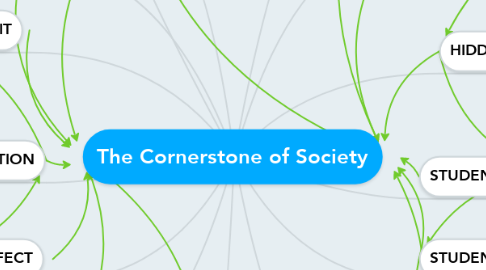The Cornerstone of Society
by christi martin

1. SOCIAL ACTIVITIES
1.1. Prepare us for life by teaching us to work together, listen, cooperate and communicate with one another.
2. ECOLOGICAL ENVIRONMENT
2.1. When identity development occurs within physical and social environments, it is called ecological environment.
3. SLEEPER EFFECT
3.1. The decline of the positive impact of the Head Start program after second grade.
4. IMPACT OF LEGISLATION
4.1. 1. The seminal U.S. Supreme Court decision that declared racially segregated schools to be inherently Unequal. 2. U.S. Supreme Court declared language cannot be a barrier to equal education opportunity.
5. CULTURAL DEFICIT
5.1. The Cultural Deficit Theory followed on the heels of the Genetic Deficit Theory and Darwinian concepts of evolution; a system of thought that had gained wide acceptance and controversy during the early 1900's
6. ACHEIVEMENT GAP
6.1. The gap between the academic achievement of White, Asian, Black, Hispanic, and Native American students.
7. HETEROGENEOUS GROUPS
7.1. Different cultures with a diverse environment of backgrounds, ideas, ethnicities, and genders.
8. PYGMALION EFFECT
8.1. The work of Rosenthal and Jacobsen (1968), among others, shows that teacher expectations influence student performance. Positive expectations influence performance positively, and negative expectations influence performance negatively. Rosenthal and Jacobson originally described the phenomenon as the Pygmalion Effect.
9. HIDDEN CURRICULUM
9.1. The elements of hidden curriculum possessed in schools are values, beliefs, attitudes, and norms and values which are important parts of school function, ceremonies and the quality of interpersonal communication.
10. STUDENT CLUBS
10.1. Although students clubs are looked at as a way in which segregation is stimulated, it gives a voice to the voiceless, and makes students feel they belong.
11. STUDENT ATHLETICS
11.1. Grows confidence, builds character, instills discipline in all areas of development.
12. DIVERSITY
12.1. Varied opinions, ideas, and attitudes toward school and life. No two people are the same, and so diversity should not impede us but express our very existence, the very essence of what we as a society represent.
13. PARENT INVOLVEMENT
13.1. Lack of parental involvement is the biggest problem facing public schools.
13.2. The more parents participate in schooling, in a sustained way, at every level in advocacy, decision-making and oversight roles, as fund- raisers and boosters, as volunteers and para- professionals, and as home teachers, the better for student achievement.
14. COMMUNITY INVOLVEMENT
14.1. Identify and integrate resources and services from the community to strengthen school programs, family practices, and student learning and development.
14.2. Information for students and families on community health, cultural, recreational, social support, and other programs/services. Information on community activities that link to learning skills and talents, including summer programs for students.


